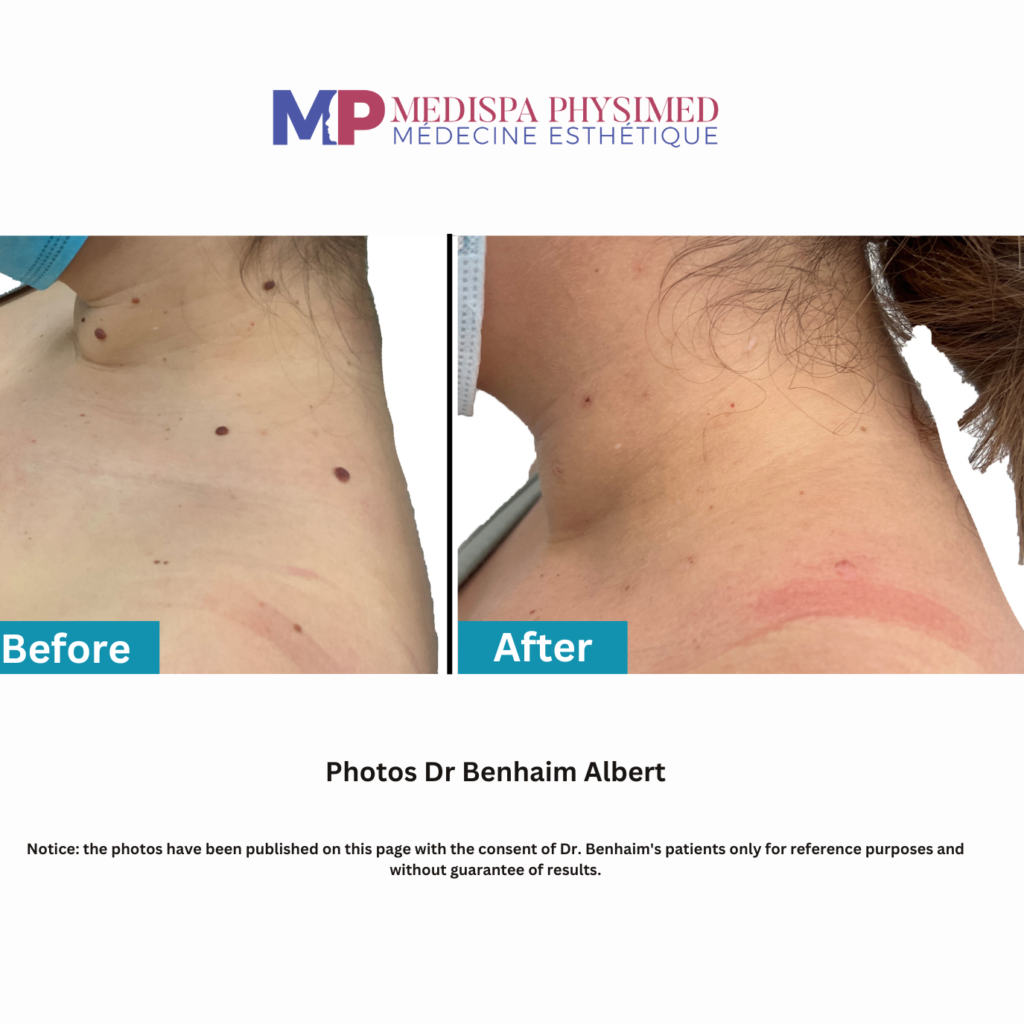Moles are small skin lesions that can be found anywhere on the body. Many patients wish to have these moles removed for health reasons, or simply for comfort and aesthetics. Several techniques are available, but some can leave unsightly scars.
In our article, discover a safe, non-invasive and painless way to remove a mole without surgery, what’s involved and how to choose a good clinic.
When should I consult a professional about removing a mole?
A mole or nevus is a small benign growth on the skin, usually brown in color. Most moles are harmless and require no treatment. However, it is vital to differentiate a benign mole from an atypical or suspicious nevus, as early diagnosis of melanoma (skin cancer) greatly increases the chances of cure.
Suspicious moles
A consultation with a dermatologist from adulthood and an annual follow-up are recommended to assess the risk of skin cancer. This is particularly necessary for people with a large number of nevi, in order to detect any signs of melanoma at an early stage. To make an appointment with a dermatologist, you must be referred by your family doctor.
Self-diagnosis using the ABCDE method
A self-examination of your moles is essential to detect any changes and consult a dermatologist in the event of unusual evolution. To help identify suspicious moles, dermatologists recommend the ABCDE method:
- “A” for Asymmetry (one side of the mole does not resemble the other)
- “B” for Border (the edges are irregular, blurred or jagged)
- “C” for Color (the color is not the same over the entire surface)
- “D” for Diameter (the mole is larger than 6 mm)
- “E” for Evolution (the mole changes size, shape or color)
- Learn more about this method
If you notice any of these signs, we recommend that you consult a dermatologist or family doctor.
Uncomfortable or unsightly moles
Even if they pose no health risk, some moles may need to be removed. Because of their size, shape or location, they may simply become a nuisance in daily life, causing discomfort when dressing, shaving or playing certain sports.
In addition, a person may decide to have a mole removed for aesthetic reasons, i.e. when it is in a visible location affecting personal appearance, such as the face, neck or any other part of the body.
It is possible to have a “troublesome” or “aesthetic” mole removed without going to a dermatologist, but through an aesthetic clinic or private clinic.

Ablative laser mole removal
There are several techniques for mole removal, including surgical removal, cryotherapy and, of course, laser excision. The choice of technique depends on various factors, such as the size, location and type of mole, as well as the patient’s individual preference.
The ablative laser technique is recommended for uncomfortable or unsightly moles. As the mole is destroyed by the laser, it cannot be subjected to histological analysis to rule out a potential cancer risk.
How does it work?
Ablative laser excision uses CO2 laser or fractionated CO2 laser technology. The latter destroys the pigment cells of the mole with precision, and is particularly effective for raised nevi. The procedure is performed under local anaesthetic on an outpatient basis, avoiding the need for hospitalization.
It is a rapid procedure, lasting around twenty minutes. If several moles need to be removed, it is possible to remove them in a single session; however, for the patient’s comfort, a two-session schedule may be envisaged for more than three moles.
Advantages of laser excision
Laser mole excision has been used in dermatology and aesthetic medicine for over 25 years. It offers several advantages over other ablation techniques:
- No scarring: thanks to the precision of this technique, laser ablation leaves little or no visible post-treatment scarring. This is not the case with surgical excision, which inevitably leaves a scar. Initially red and visible, it fades over time to become whiter but never completely disappears, which can be aesthetically embarrassing.
- Reduced recovery time: After the operation, a small scab forms and falls off after a few days. As with all ablation techniques, it is essential to protect the skin from the sun for several months to promote optimal healing and avoid the harmful effects of light.
- Treats multiple skin lesions: Used for moles, the ablative laser is also highly effective on other types of skin lesions, such as skin tags, cutaneous fibroids, seborrheic and actinic keratoses (keratin outgrowths), angiomas and spider veins. To find out more.
Which doctor should I consult to remove a mole?

It’s essential to choose a physician qualified in aesthetic treatments or dermatology, for procedures on sensitive areas such as the face that require precision. The specialist’s professional background should include solid experience in mole treatment and scar management, as well as specific competence for certain areas at risk of difficult healing.
Dr. Albert Benhaim, a family physician at Medispa Physimed (Montreal), specializes in aesthetic medicine and has developed in-depth expertise in non-surgical laser treatments. The Medispa Physimed medical-aesthetic clinic offers treatments such as the Fotona laser to treat a variety of skin lesions.
“Wonderful staff and high quality work! I did a laser mole removal operation and the results are great thus far! Highly recommend!”















